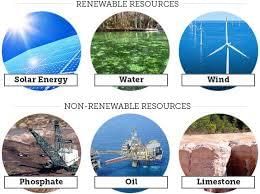The Earth and its resources | Year 8 Physics (Cambridge) - Class 8 PDF Download
| Table of contents |

|
| Introduction |

|
| Renewable Resources |

|
| Non-Renewable Resources |

|
| Comparing Renewable and Non-Renewable Resources |

|
Introduction
The Earth provides us with many resources that we use every day. These resources can be divided into two main categories: renewable and non-renewable. Understanding the difference between these two types of resources is essential for managing them sustainably.
Renewable Resources
Renewable resources are resources that can be replenished or regenerated over time. They are naturally replenished faster than they are consumed. These resources are often more sustainable because they are less likely to run out.
Examples of Renewable Resources
- Solar Energy: Energy from the sun. Solar panels can convert sunlight into electricity.
- Wind Energy: Energy from the wind. Wind turbines can harness the wind's power to generate electricity.
- Water (Hydropower): Energy from moving water. Dams and turbines can capture the energy from flowing water to produce electricity.
- Biomass: Organic materials such as plants and animal waste. These can be used to produce biofuels like ethanol and biodiesel.
- Geothermal Energy: Heat from the Earth's interior. Geothermal plants can use this heat to generate electricity.

Non-Renewable Resources
Non-renewable resources are resources that do not replenish quickly enough to keep up with their rate of consumption. Once these resources are used up, they are gone forever or take millions of years to form again.
Examples of Non-Renewable Resources
- Fossil Fuels: Coal, oil, and natural gas. These are formed from the remains of ancient plants and animals over millions of years. They are burned for energy but release greenhouse gases.
- Minerals: Metals like gold, silver, and iron. These are mined from the Earth and are used in various industries. They do not regenerate on a human timescale.
- Nuclear Energy: Uses uranium and other radioactive elements. While efficient, the supply of these elements is limited, and their use generates radioactive waste.
Comparing Renewable and Non-Renewable Resources
- Availability: Renewable resources are abundant and can be replenished. Non-renewable resources are limited and will eventually run out.
- Environmental Impact: Renewable resources generally have a lower environmental impact. Non-renewable resources often cause pollution and environmental damage.
- Cost: The initial cost of renewable energy systems can be high, but operational costs are low. Non-renewable resources can be cheaper to extract and use, but their environmental costs are high.

Importance of Renewable Resources
- Renewable resources are crucial for sustainable development.
- They provide cleaner alternatives to fossil fuels and help reduce pollution and greenhouse gas emissions.
- Investing in renewable energy technologies can also create jobs and promote energy independence.
Challenges with Renewable Resources
While renewable resources have many benefits, there are also challenges:
- Intermittency: Solar and wind energy depend on weather conditions and time of day.
- Storage: Storing renewable energy efficiently remains a challenge.
- Infrastructure: Upgrading infrastructure to support renewable energy can be costly.
Conclusion
Understanding the difference between renewable and non-renewable resources helps us make informed decisions about energy use and conservation. By focusing on renewable resources, we can work towards a more sustainable and environmentally friendly future.
|
8 videos|39 docs|11 tests
|
FAQs on The Earth and its resources - Year 8 Physics (Cambridge) - Class 8
| 1. What are some examples of valuable resources found on Earth? |  |
| 2. Why is it important to understand and manage Earth's resources effectively? |  |
| 3. How do schools in the UK educate students about Earth's resources? |  |
| 4. What are some common challenges associated with the utilization of Earth's resources? |  |
| 5. How can individuals contribute to the conservation of Earth's resources in their daily lives? |  |




















